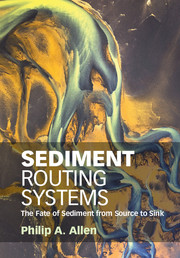Book contents
- Frontmatter
- Contents
- Preface
- Part I A Global View of Sediment Routing Systems
- 1 Sediment Routing Systems: First Concepts
- 2 The Global Character of River Basins
- 3 Global Biogeochemical Cycles
- Part II The Segments of Sediment Routing Systems
- Part III The Functioning of Sediment Routing Systems
- Part IV The Stratigraphic Record of Sediment Routing Systems
- References
- Index
1 - Sediment Routing Systems: First Concepts
from Part I - A Global View of Sediment Routing Systems
Published online by Cambridge University Press: 03 October 2017
- Frontmatter
- Contents
- Preface
- Part I A Global View of Sediment Routing Systems
- 1 Sediment Routing Systems: First Concepts
- 2 The Global Character of River Basins
- 3 Global Biogeochemical Cycles
- Part II The Segments of Sediment Routing Systems
- Part III The Functioning of Sediment Routing Systems
- Part IV The Stratigraphic Record of Sediment Routing Systems
- References
- Index
Summary
How Sediment Routing Systems Function
Sediment routing systems link the fate of particulate sediment from source to sink, and essentially frame the problems of denudation, sediment transport and deposition as a box model characterised by sources, reservoirs and sinks with connecting fluxes (Figure 1.1). Sediment routing systems, or denudation-accumulation systems (Einsele, Ratschbacher, and Wetzel, 1996; Hinderer and Einsele, 2001), are integrated, dynamical systems connecting regions of erosion, sediment transfer, temporary storage and long-term deposition (Meade, 1972, 1982; Schumm, 1977; Castelltort and Van Den Driessche, 2003; Allen and Allen, 2013; Romans and Graham, 2013; Sadler and Jerolmack, 2015). They involve a sediment cascade (Burt and Allison, 2010) from single or multiple source regions to long-term depositional sinks via a series of geomorphic environments characterised by intermittent storage (Section 1.2). The sediment routing system philosophy therefore firmly places geomorphology, sedimentology and stratigraphy within an Earth system context, but also forms the framework for allied investigations of, for example, global biogeochemical cycles.
Sediment routing systems represent a vigorous way in which the Earth recycles mass, and their dynamics are fundamental to global responses to, for example, supercontinental assembly and dispersal, mountain building and climate change (Whipple, 2009). They also provide thoroughfares for the transmission of chemical signals from mountains to the ocean (Meybeck, 1987; Hay, 1998; Galy et al., 2007). Sediment routing systems therefore participate strongly in many geochemical cycles, such as that of carbon (Leithold, Blair, andWegmann, 2015), including in the drawdown of atmospheric CO2 mediated by rates of chemical weathering (Raymo and Ruddiman, 1992), in the delivery of particulate organic carbon to the ocean and its removal from the short-term carbon cycle by rapid burial in deltas and sediment fans (France-Lanord and Derry, 1997; Galy et al., 2007), in the charging of coastal waters with nutrients (Orive, Elliott, and de Jong, 2002) and in the catalysing of ocean anoxia in sheltered and semi-enclosed seas by changes in freshwater discharge of rivers (Beckmann et al., 2005).
The concept of sediment routing systems was not until recently part of mainstream geological thinking, despite the fact that sediment provenance, based on sediment mineralogy (Boswell, 1933; Pettijohn, Potter, and Siever, 1987), bulk composition (Dickinson and Suczek, 1979) and palaeocurrents (Potter and Pettijohn, 1977), has been studied systematically for many years.
- Type
- Chapter
- Information
- Sediment Routing SystemsThe Fate of Sediment from Source to Sink, pp. 3 - 19Publisher: Cambridge University PressPrint publication year: 2017
- 1
- Cited by



